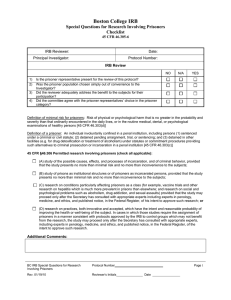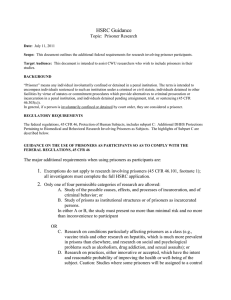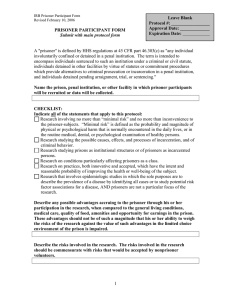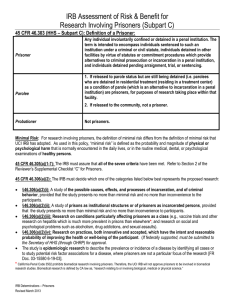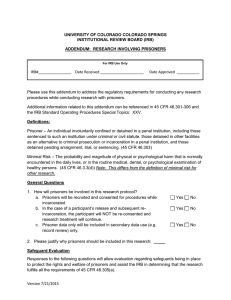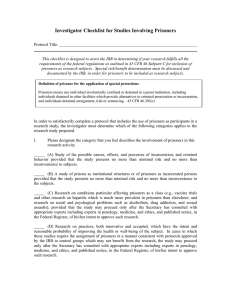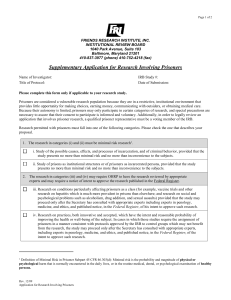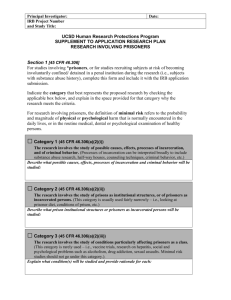IBC INSTITUTIONAL BIOSAFETY COMMITTEE
advertisement
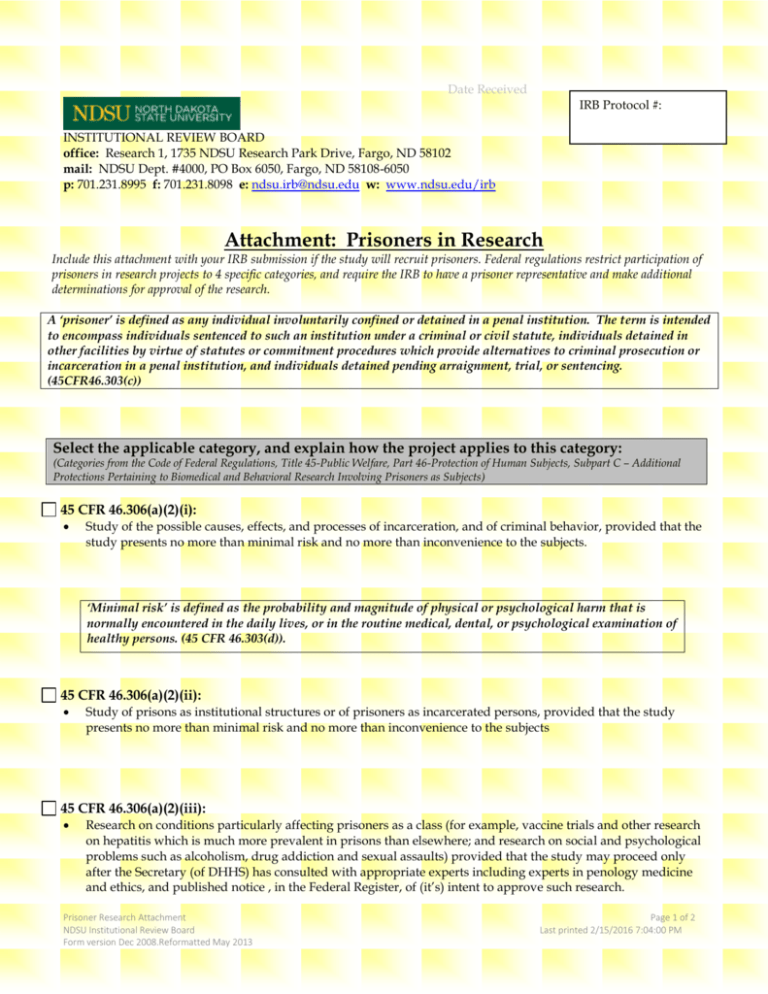
Date Received IRB Protocol #: INSTITUTIONAL REVIEW BOARD office: Research 1, 1735 NDSU Research Park Drive, Fargo, ND 58102 mail: NDSU Dept. #4000, PO Box 6050, Fargo, ND 58108-6050 p: 701.231.8995 f: 701.231.8098 e: ndsu.irb@ndsu.edu w: www.ndsu.edu/irb Attachment: Prisoners in Research Include this attachment with your IRB submission if the study will recruit prisoners. Federal regulations restrict participation of prisoners in research projects to 4 specific categories, and require the IRB to have a prisoner representative and make additional determinations for approval of the research. A ‘prisoner’ is defined as any individual involuntarily confined or detained in a penal institution. The term is intended to encompass individuals sentenced to such an institution under a criminal or civil statute, individuals detained in other facilities by virtue of statutes or commitment procedures which provide alternatives to criminal prosecution or incarceration in a penal institution, and individuals detained pending arraignment, trial, or sentencing. (45CFR46.303(c)) Select the applicable category, and explain how the project applies to this category: (Categories from the Code of Federal Regulations, Title 45-Public Welfare, Part 46-Protection of Human Subjects, Subpart C – Additional Protections Pertaining to Biomedical and Behavioral Research Involving Prisoners as Subjects) 45 CFR 46.306(a)(2)(i): Study of the possible causes, effects, and processes of incarceration, and of criminal behavior, provided that the study presents no more than minimal risk and no more than inconvenience to the subjects. ‘Minimal risk’ is defined as the probability and magnitude of physical or psychological harm that is normally encountered in the daily lives, or in the routine medical, dental, or psychological examination of healthy persons. (45 CFR 46.303(d)). 45 CFR 46.306(a)(2)(ii): Study of prisons as institutional structures or of prisoners as incarcerated persons, provided that the study presents no more than minimal risk and no more than inconvenience to the subjects 45 CFR 46.306(a)(2)(iii): Research on conditions particularly affecting prisoners as a class (for example, vaccine trials and other research on hepatitis which is much more prevalent in prisons than elsewhere; and research on social and psychological problems such as alcoholism, drug addiction and sexual assaults) provided that the study may proceed only after the Secretary (of DHHS) has consulted with appropriate experts including experts in penology medicine and ethics, and published notice , in the Federal Register, of (it’s) intent to approve such research. Prisoner Research Attachment NDSU Institutional Review Board Form version Dec 2008.Reformatted May 2013 Page 1 of 2 Last printed 2/15/2016 7:04:00 PM 45 CFR 46.306(a)(2)(iv): Research on practices, both innovative and accepted, which have the intent and reasonable probability of improving the health or well-being of the subjects. In cases in which those studies require the assignment of prisoners in a manner consistent with protocols approved by the IRB to control groups which may not benefit from the research, the study may proceed only after (DHHS) has consulted with appropriate experts, including experts in penology medicine and ethics, and published notice, in the Federal Register, of it’s intent to approve such research. Additional determinations required for research involving prisoners (45CFR46.305): Indicate how the research will satisfy each of the following criteria: The risks involved in the research are commensurate with risks that would be accepted by nonprisoner volunteers. Any possible advantages accruing to the prisoner through his or her participation in the research, when compared to the general living conditions, medical care, quality of food, amenities and opportunity for earnings in the prison, are not of such a magnitude that his or her ability to weigh the risks of the research against the value of such advantages in the limited choice environment of the prison is impaired. Procedures for the selection of subjects within the prison are fair to all prisoners and immune from arbitrary intervention by prison authorities or prisoners. Unless the principal investigator provides to the IRB justification in writing for following some other procedures, control subjects must be selected randomly from the group of available prisoners who meet the characteristics needed for that particular research project. The information is presented in language which is understandable to the subject population. Adequate assurance exists that parole boards will not take into account a prisoner’s participation in the research in making decisions regarding parole, and each prisoner is clearly informed in advance that participation in the research will have no effect on his or her parole. Where the IRB finds there may be a need for follow-up examination or care of participants after the end of their participation, adequate provision has been made for such examination or care, taking into account the varying lengths or individual prisoners’ sentences, and for informing participants of this fact. Prisoner Research Attachment NDSU Institutional Review Board Form version Dec 2008.Reformatted May 2013 Page 2 of 2 Last printed 2/15/2016 7:04:00 PM
